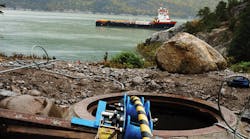Latest from FTTx/Optical Networks
While some might think that satellites are responsible for a lot of the transmissions around the world, submarine cables handle 95% of data, voice, and Internet traffic.
All-Fiber Connectivity at Cable Landing Stations
Cyberspace. It’s the word we use to describe that netherworld between your phone, computer, or other device, and the information that comes to it from beyond. A lot of the time that information or data is not coming from space, but from the sea.
Submarine cables have connected the world’s continents for more than 100 years, first making telegraph communication possible in the 1800s. Past cables housed metal wires, but today’s cables house fiber optic filaments that are about the thickness of a human hair. One cable can hold hundreds of fibers, meaning one cable can have a massive bandwidth capacity. In 2017, there were 428 submarine cables around the world, more than twice as many as there were in 2012, according to Telegeography’s submarine cable map.1
Submarine cables are the method of choice for providing connectivity between the United States and the rest of the world.2
In fact, while some might think that satellites are responsible for a lot of the transmissions around the world, submarine cables handle 95% of data, voice, and Internet traffic. Even more impressive is that this percentage continues to increase. Transmission via submarine cables is faster, cheaper, more secure, and more reliable.3
[pullquote]In 2017, there were 428 submarine cables around the world, more than twice as many as there were in 2012, according to Telegeography’s submarine cable map.[/pullquote]
The speed, cost-effectiveness, and security of submarine cables will become more important as more data is created. Today, the world’s digital data equals about 900 exabytes. Ninety percent (90%) of that was created in the last two years alone.4 Big data will depend on the Cloud. The Cloud will undoubtedly get bigger, and, along with it, we will see an increased demand for connectivity.
Making Landfall
Cable landing stations serve as the meeting point where submarine cables intersect with terrestrial networks. Cable landing stations located on the east coast of the US link the majority of trans-Atlantic cables to Europe, Central America, South America, and Africa.
Once data has traversed the submarine cable, it has already traveled thousands of miles, which adds to its latency. From the cable landing station, the challenge is to get that data where it needs to go on land, and as fast as possible. Utilizing all-fiber connectivity from the cable landing station to the destination is the fastest and most efficient way to complete the data’s journey.
Minimizing latency is critical for high performance networks that serve mission critical functions like telecommunications, Cloud infrastructure, and financial services. Knowing that trans-oceanic latency can be managed only so much, network designers try to maximize performance on the terrestrial portions of their circuits.
Data centers are a major destination for traffic coming from, or heading to, cable landing stations. Once linked with a data center, organizations can: access local resources there like servers, and connect to Cloud providers, other data centers, or office locations. With this in mind, it is important to use an all-fiber service provider that is connected to cable landing station. It’s also critical that your customers use a service provider that is also connected to your data center.
Connecting the Dots
An all-fiber connection provides the bandwidth and the speed for the data that is coming or going via submarine cable. Fiber networks are the most flexible and most future proof networks, supporting virtually limitless bandwidth, multi-service support, and complete latency management.
When it comes to choosing a fiber provider, the network is key. Where do they connect, what routes do they offer between your 2 locations, and how will they support your clients?
There is no telling how far and fast the demand for intercontinental connectivity will go. Lightower Fiber Networks offers limitless possibilities, and can provide all-fiber connectivity to cable landing stations from Virginia to Massachusetts.
Endnotes
1. https://www.telegeography.com/telecom-resources/submarine-cable-map/index.html
2. https://www.fcc.gov/submarine-cables
3. https://transition.fcc.gov/pshs/advisory/csric4/CSRIC_IV_WG8_Report1_3Dec2014.pdf
4. https://www.mushroomnetworks.com/infographics/the-landscape-of-big-data-infographic




